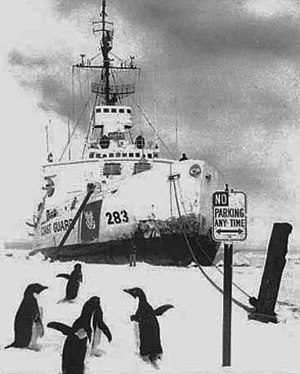Burton Island
 |
|
| History | |
|---|---|
| Name: | USS Burton Island (AG-88) |
| Namesake: | An island off the coast of Delaware |
| Builder: | Western Pipe and Steel Company (WPS), San Pedro, California |
| Cost: | US$9.880,037.00 |
| Laid down: | 15 March 1946 |
| Launched: | 30 April 1946 |
| Christened: | 1946 |
| Completed: | 1946 |
| Commissioned: | 28 December 1946 |
| Decommissioned: | 15 December 1966 |
| Maiden voyage: | 17 January 1947 |
| In service: | 8 December 1946 |
| Out of service: | 15 December 1966 |
| Struck: | 1966 |
| Identification: |
|
| Nickname(s): | B.I. |
| Fate: | Transferred to U.S. Coast Guard |
|
|
|
| Name: | USCGC Burton Island (WAGB-283) |
| Recommissioned: | 15 December 1966 |
| Decommissioned: | 9 May 1978 |
| Homeport: |
|
| Identification: | Call sign: NEVK |
| Nickname(s): |
|
| Fate: | Sold for scrap, 17 August 1980 |
| General characteristics | |
| Class and type: | Wind-class icebreaker |
| Displacement: | 6,515 tons (1945) |
| Length: | 269 ft (82 m) |
| Beam: | 63 ft 6 in (19.35 m) |
| Draft: | 25 ft 9 in (7.85 m) |
| Installed power: | 6 × Fairbanks-Morse 8-1/8OP 10-cylinder opposed-piston engines (6 × 2,000 hp) |
| Propulsion: |
|
| Speed: | 13.4 knots (24.8 km/h; 15.4 mph) |
| Range: | 32,485 mi (52,280 km) |
| Endurance: |
|
| Boats & landing craft carried: |
4 lifeboats. 1 LCVP. 1 Greenland Cruiser, later Arctic Survey Boat (ASB) |
| Sensors and processing systems: |
|
| Armament: |
|
| Aircraft carried: | 2 single rotor helicopters and air detachment personnel |
| Aviation facilities: | Flight deck and retractable hangar with aircraft service capabilities |
USS Burton Island (AG-88) was a United States Navy Wind-class icebreaker that was later re-commissioned in the United States Coast Guard as the USCGC Burton Island (WAGB-283). She was named after an island near the coast of Delaware.
Burton Island was one of the icebreakers designed by Lt Cdr Edward Thiele and Gibbs & Cox of New York, who modeled them after plans for European icebreakers he obtained before the start of World War II. She was the sixth of seven completed ships of the Wind-class of icebreakers operated by the United States Coast Guard. Her keel was laid on 15 March 1946 at Western Pipe and Steel Company shipyards in San Pedro, California, she was launched on 30 April 1946, and commissioned on 28 December 1946 with Commander Gerald L. Ketchum in command.
Her hull was of unprecedented strength and structural integrity, with a relatively short length in proportion to the great power developed, a cut away forefoot, rounded bottom, and fore, aft and side heeling tanks. Diesel electric machinery was chosen for its controllability and resistance to damage.Burton Island was built during peacetime, so she had a much lighter armament than her war-built sisters, one 5 in (130 mm) 38 cal. deck gun and three quad-mounted Bofors 40 mm anti-aircraft autocannons when in Navy service, and unarmed for the Coast Guard.
On 17 January 1947, Burton Island, loaded with supplies, steamed from San Diego to the Ross Sea, Antarctica where she met with units of TF 68 on the first Antarctica Development project, Operation Highjump. After returning from Antarctica, Burton Island departed 25 July 1947 for the Point Barrow expedition to Alaska.
...
Wikipedia
